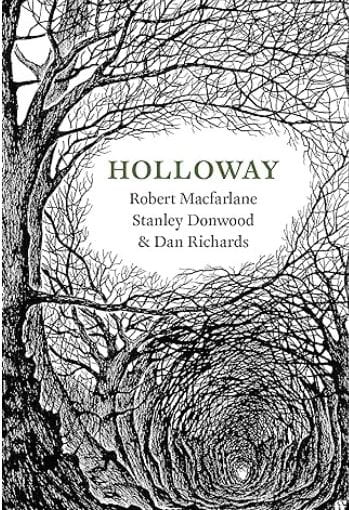I first came across Robert Macfarlane in a book called Lost Words that he created with Jackie Morris. It was beautiful, both visually and wordly. A children’s dictionary was removing some words that were hardly ever used and Macfarlane and Morris were horrified. They were words to do with nature. What happens if you can’t look up words that are to do with the natural world? Fern, heather, kingfisher, otter, raven, willow, wren. So Holloway held few surprises for me.
Holloways are sunken paths or shady lanes, tracks that have been worn over centuries ‘landmarks that speak of habit rather than sudden-ness’. Most holloways begin as ways to markets, the sea or pilgrimages and have tributaries and branches. The description makes me think of Watery Lane near me, a covered over track, now tarmaced, that leads down to the sea with branches off that end in housing but would have once led to a singular dwelling, hostelry or other tracks.
Greenways, droveways, stanways, stoweys, bradways, whiteways, reddaways, radways, rudways, halsways, roundways, trods, footpaths, field-paths, leys, dykes, drongs, sarns, snickets, bostles, shutes, driftways, licjways, sandways, ridings, halter-paths, cartways, carneys, causeways, here-paths-& also fearways, dangerways, coffin-paths, corpseways & ghostways.
p3
Each part of the country probably has their own words for them. I know snickets which my paternal grandparents uses for the pathways around them in Exmouth.
The book is an evocation of two trips by Macfarlane to find a particular holloway in Dorset, once with Roger Deakin and then with Donwoods and Richards. It is a very slim book, but just the right amount of Macfarlane/Richards’ writing as I can take. Like a too-rich chocolate cake, his longer books are more than I can take. The writing is poetic, descriptively historic and linguistically rich. I am unsure which parts Macfarlane wrote and which parts Richards wrote or whether the words were created jointly.
Down in the dusk of the holloway, the landscape’s pasts felt excitingly alive & coexistent, as if history had pleated back on itself, bringing discontinuous moments into contact & creating correspondences that survived as a territorial imperative to concealment, escape and encounter.
p13
There is no map of this place, you have to explore, read the landscape and be prepared to slither and slide but once in it you are back in time and still present.
Looking out from the lower turf ramparts of Pilsdon Pen we sight a crescent moon of hills – a vein within a leaf spring – arcing to the coast. Somewhere in there lies our quarry; a lane diving into the dark.
An inky eye ammonite.
A hollow, foot-querned way.
p27
A quern is a hand-operated mill to grind grain.
What the book also contains is a testament to male friendship. Out exploring and discovering on foot or bicycle, carrying few things other than blunt knives and alcohol but also books of poetry to read out aloud at night by the fire and an openness to soak up what the landscape is telling you.
The illustrations by Stanley Donwood – now there is a surname – show the closed overness, the hidden and the tunnel-like depths and reminded me of altered books created by Alexi Francis.
I loved it.
